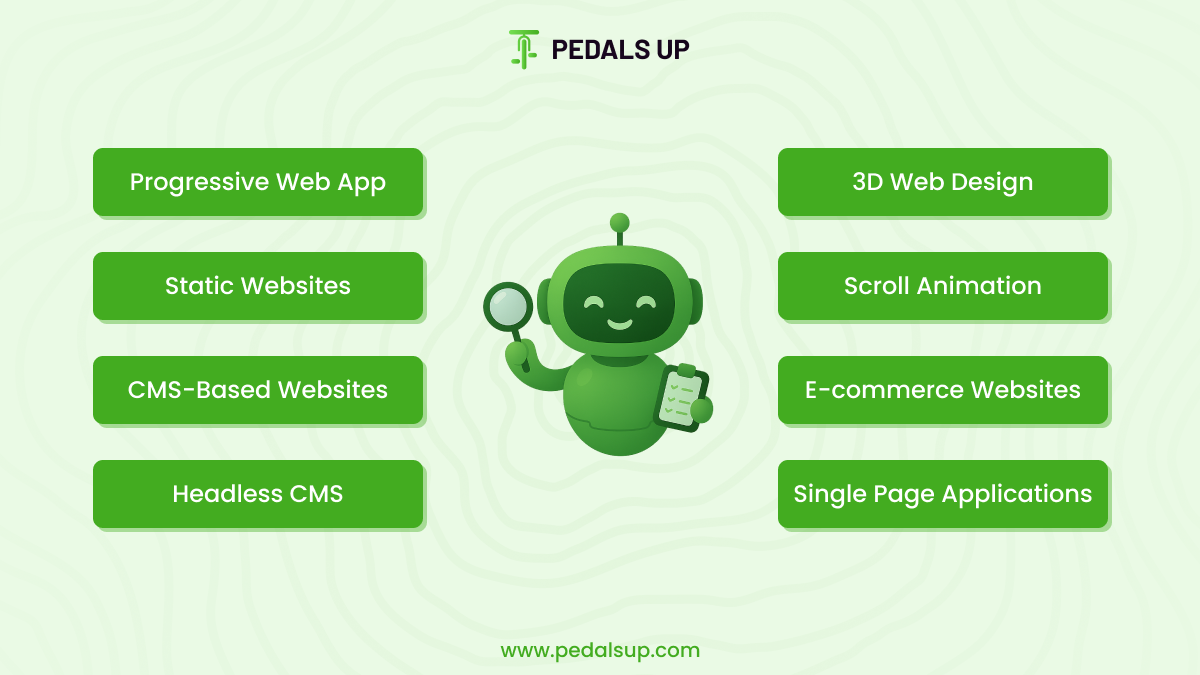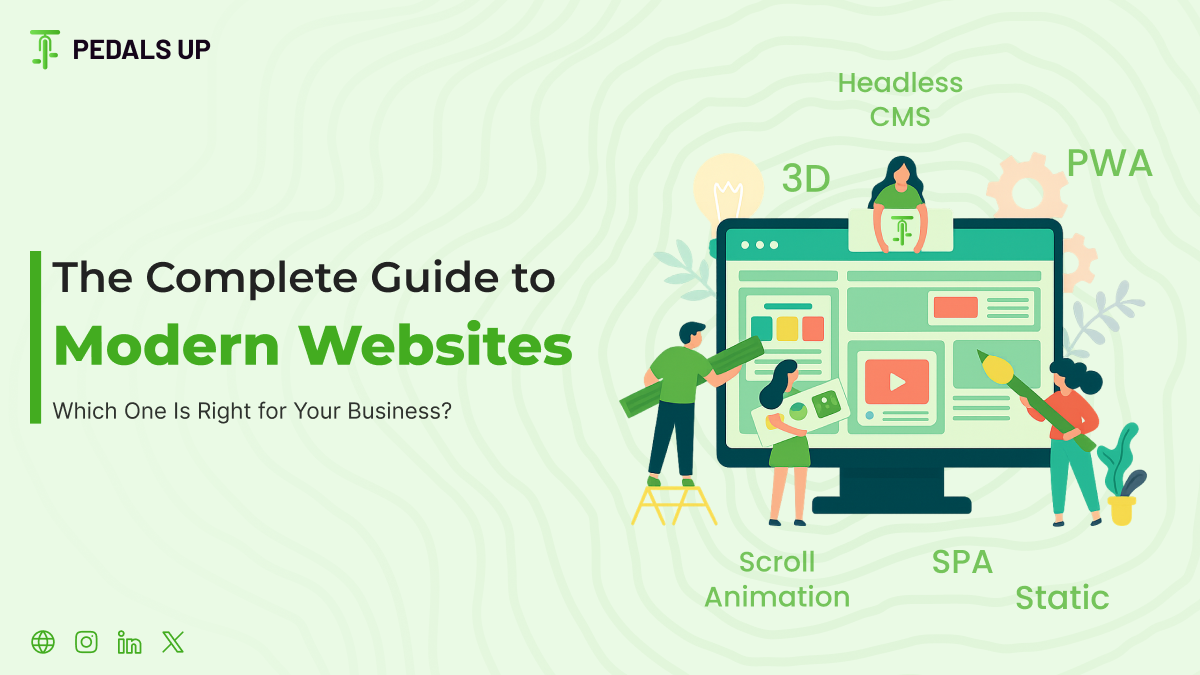Introduction
Your website isn’t just an online presence; it’s the digital pulse of your business. For 2025, it’s your sales driver, your make-or-break first impression, and a scalable growth platform. Yet, with so many different development strategies, how do you determine which one is ideally suited to your individual vision?
Whether you’re starting a revolutionary startup, growing a successful SaaS product, or changing your e-commerce footprint, your website’s underpinning – its tech stack – needs to fit exactly with your goals.
Let’s examine the 8 top website types for today’s vibrant digital world, outlining their purpose, functionality, and built-in pros and cons.

1. Static Websites: The Speed & Security Champions
What they are: Pre-rendered HTML, CSS, and JavaScript files served directly to users through Content Delivery Networks (CDNs). Consider them super-efficient, pre-built pages. Popular builders include Hugo, Jekyll, and Eleventy.
Best for: Basic brochure sites, high-performance landing pages, small businesses, and personal portfolios.
Real-world example: Paul Graham’s austere and well-known fast website.
Key Benefits:
- Blazing-fast loading speeds
- Exceptional security
- Cost-effective hosting
Considerations:
- Rebuild process required for updates
- No personalization or dynamic content
2. CMS-Based Dynamic Websites: Content Powerhouses' Flexibility
What they are: Dynamically retrieve content from a backend database and display it in real-time for every user request. Non-technical teams can update content easily. Think Webflow or WordPress.
Best for: Blogs, content sites, news sites, and companies with regular content updates.
Examples in the wild: White House website, TechCrunch (WordPress).
Key Benefits:
- Easy content updates
- Rich plugin/theme ecosystem
- Robust SEO tools
Considerations:
- Slower than static sites
- More maintenance and security requirements
3. Headless CMS + Jamstack: The Future-Proof Performance Play
What it is: Content is kept in an independent CMS (e.g., Contentful, Sanity) and served through APIs to an independent frontend developed using next-gen frameworks such as Next.js. This separates content from presentation.
Best suited for: Brands that need extreme scale, leading-edge performance, omnichannel distribution, and utmost design freedom.
Examples in the real world: Nike, Figma’s blog.
Top Benefits:
- Lightning-fast + dynamic
- Flexible API integrations
- Omnichannel ready
Considerations:
- Needs developer proficiency
- Content previewing requires tooling
Real Case Study: Figma moved from a monolithic CMS to a headless stack with Next.js + Sanity. This boosted global load times by 40% and provided marketing teams with more content control.
4. Single-Page Applications (SPAs): Providing App-Like Experiences
What they are: One HTML page fueled by JavaScript, where content is dynamically loaded without full page reloads. Developed with frameworks such as React, Vue, or Angular.
Ideal for: SaaS dashboards, interactive web applications, internal user portals, and collaborative tools.
Real-world examples: Notion, Asana.
Key Benefits:
- Seamless user experience
- Highly interactive
- App-like responsiveness
Considerations:
- SEO difficulties without SSR
Slower initial load time
5. 3D Web Design: Immersive Visual Storytelling
What it is: Sites using WebGL, Three.js, or Babylon.js to present breathtaking 3D graphics directly within the browser.
Ideal for: High-end e-commerce, real estate, automobile configurators, and immersive gaming experiences.
Real-world examples: BMW Virtual Viewer, Adidas Originals Ozworld.
Key Benefits:
- Exceptional interaction
- Premium brand quality
- Rich product demos
Considerations:
- Heavy asset performance impact
- Needs niche development skills
6. SVG + Scroll Animation Sites: Sleek, Light Interactions
What it is: Sites that utilize Scalable Vector Graphics (SVGs) animated with CSS, JavaScript, or libraries such as GSAP. Frequently triggered or driven by user scroll.
Best for: Creative agencies, technology product demos, education platforms, and data visualizations.
Real-world examples: Stripe Radar, Growwwkit.
Key Benefits:
- Crisp visuals across all screens
- Involving scroll-driven storytelling
- Lightweight if well coded
Considerations:
- DOM complexity can damage performance
- Animation contributes to dev time
7. E-commerce Websites: Your Online Storefront for Sales
What it is: Specialized online storefronts optimized for product discovery, secure checkout, and post-purchase automation. Includes Shopify, WooCommerce, and custom implementations.
Best suited for: Retail brands, DTC companies, digital goods sellers, and marketplaces.
Real-life examples: Allbirds, Glossier.
Key Advantages:
- Integrated payments, shipping, inventory
- Powerful analytics and CRO features
- Sell on web, social, and in-store
Things to consider:
- App overload can degrade speed
- Customization can be restricted
Real Data: Shopify sellers operating on Hydrogen + Oxygen experience 35% quicker load time and 18% increased conversions.
8. Progressive Web Apps (PWAs): Converging Web & Mobile Experience
What are they: Web apps that have native app-like behavior. Installable, offline-enabled, and with push notifications.
Best suited for: News websites, SaaS software, learning, and apps with high engagement needed.
Real-world applications: Twitter Lite, Flipkart PWA.
Major Advantages:
- Offline works
- Native app feeling
- Skips app store gatekeeping
Considerations:
- Limited support on older browsers
- Service Worker setup complexity
Summary: Which Website Type Should You Choose for 2025?
Goal | Best Website Type |
Showcase product in 3D | 3D/WebGL |
Launch fast and affordably | Static or CMS |
Scale with flexibility | Headless CMS + Jamstack |
Create an app-like UX | SPA or PWA |
Drive e-commerce sales | Shopify/Custom E-commerce |
Tell a compelling visual story | SVG + Scroll Animation |
Still uncertain? Ask yourself:
- How frequently will content need to be updated?
- How interactive should the experience be?
- How critical is fast performance and organic traffic?
Why Pedals Up?
We don’t merely create websites at Pedals Up—we craft digital solutions that scale businesses. We’ve enabled brands such as Unbundl, Indra Exchange, and Fynd to launch scalable, conversion-driven platforms. From headless stacks to immersive 3D web applications, we create strategic impact.




